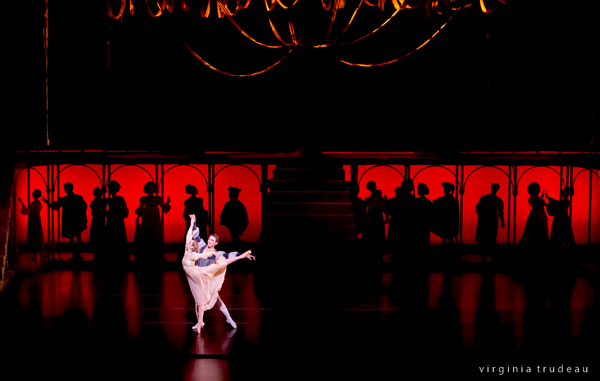NBT’S ROMEO AND JULIET
By: Hal de Becker
It may be a tragedy and one of Shakespeare’s greatest, but NBT’s Romeo and Juliet ballet at The Smith Center last weekend left the audience joyfully cheering and applauding.
Choreographed by James Canfield in 1989, it was a superb dance-drama, direct, uncluttered and sure of itself every step of the way.
The brilliant score by Serge Prokofiev is rightly considered to be one of the most perfect of the ballet genre. All the story’s emotions and actions are reflected in the music and Canfield’s choreography responded to it with penetrating sensitivity.
The ballet consisted of thirteen scenes which might sound a bit much, but wasn’t. They were so skillfully managed and interesting that they enhanced the work’s pace with a sense of always driving forward.
Of course, not all the play’s details and roles could be included in the ballet, but the impression was not of a stripped down version but of a streamlined one.
The production’s stars may have been the dynamic and innovative sets and lighting that were a feast for the eyes and foretold the fate of the doomed young lovers almost as effectively as did the excellent dancing and stage action.
Sets were credited to Studio Concepts, Gene Dent and Gene Buck; lighting to Peter Jakubowski. Their creative efforts in their respective arts resulted in masterworks. The moonlit balcony scene, the graceful hanging draperies of Juliet’s bedroom, the grim crypt with its overhead iron grill all matched the story perfectly.
The most dramatic scene, visually and musically, was the Capulet Ball. Its black, two level, wrought iron structure resembled the skeletal framework of an unfinished building. The catwalk on top was supported by twelve arches. Under each arch a dancer was framed in silhouette against a blood red background. It might have been inspired by one of Edgar Allan Poe’s macabre stories.

Some of the ballet’s scenes were played with a backdrop on which two angels were depicted. It suggested a huge tapestry that might have hung in a Renaissance palace. The same sense of authenticity was evoked by David Heuvel’s luxurious costumes.
Act I opened with a tableau introducing some of the main characters posed in a row across the stage. Among them were Romeo, his friends Mercutio and Benvolio and his enemy Tybalt; also Juliet, her suiter Paris, her parents Lord and Lady Capulet and her devoted confidant Nurse.
Act II opened with the same tableau but because Mercutio and Tybalt had been killed in the prior Act the positions they had formerly occupied were glaringly empty. It was a chilling theatrical effect.
When the story begins, Juliet is an innocent young girl but when it ends she is a woman who has loved and suffered. A performer must possess abundant range to be persuasive in such a challenging role. Michelle Meltzer was not always such a one.
In her transforming first meeting with Romeo her reaction had no magic; despite her girlish innocence she showed no confusion or unease being touched by him; and Juliet’s courage in defying her autocratic father was not well established.
She began to warm to the role in the balcony love duet, and by the ballet’s final scenes her acting had more impact. Always apparent though, were her lyricism and purity of line, especially in her adagio duets with Romeo and Paris.
Benjamin Tucker danced with virility and persuasive acting as the impulsive, smitten youth Romeo. When caught between his feelings for Juliet and his killing of her cousin Tybalt, Romeo’s quandary was successfully conveyed, as was his despair in the Crypt believing Juliet to be dead.
Stephan Azulay’s portrayal of the reckless, flamboyant Mercutio was adequate but lacked panache; David Hochberg, as Benvolio, had youthful vigor. Together with Tucker, they provided some of the ballet’s brightest dancing in solos and trios that displayed their strong technical skills.
Steven Goforth cut an imposing figure as Lord Capulet, and Christina Ghiardi as the elegant Lady Capulet became a veritable tigress when seeking vengeance after Tybalt’s death. In another effective scene, she was just a mother, broken and in a trance, tenderly rocking her dead Juliet in her arms as though she was a baby again.
Sergio Alvarez brought a menacing presence to the role of Tybalt; Krista Baker, in life a slender classical dancer, was delightful in disguise as the plump, cloddish Nurse; Morgan Stillman as Paris provided good partnering in his duet with Juliet.
Fencing sections in ballets are usually unconvincing replications of kids at play. But in this ballet they were exciting with every thrust and parry realistically choreographed to the music.
Leigh Collins, Caroline MacDonald, Emma McGirr and Katherine Zimmerman made an impressive quartet in the bedroom flower dance. The corps de ballet, including company members, apprentices and trainees, danced beautifully. They were a credit to NBT’s new ballet mistress, Tara Foy, who trains and rehearses them.
Special kudos to Audra and Bobby Baldwin and the others who sponsored this splendid performance.


